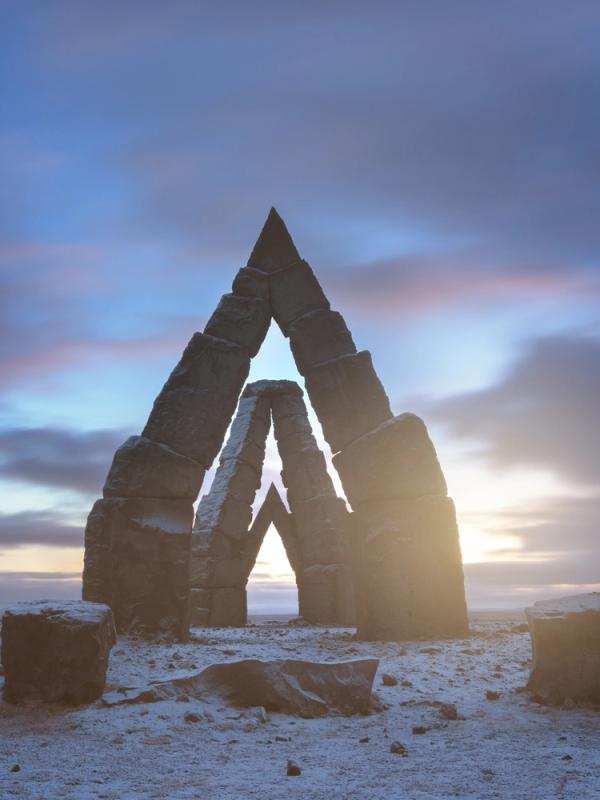
The Arctic Henge, a Place Where Nature and Mythology Come Together
The Arctic Henge is a structure created to honor the country’s Norse roots and has been built in an outstanding natural environment. This stone monument is inspired by mythological tales and attracts visitors who seek a blend of culture and nature.
Surrounded by the vast North Atlantic Ocean, this site is a great stop to add to an itinerary with a campervan through this part of the country.
Come with us to learn everything there's to know about the Arctic Henge, as well as places where you can spend the night.
Key takeaways
- The Arctic Henge is a monument built to pay tribute to Norse mythology.
- It’s located near Raufarhöfn, Iceland’s northernmost mainland village, in the Northeastern Region.
- It consists of several structures with deep symbolism.
What's The Arctic Henge?
The Arctic Henge, known in Icelandic as Heimskautsgerðið, is a large stone structure built from basalt columns. Some visitors say it resembles a contemporary version of England's Stonehenge but with deep ties to Norse mythology. Situated on a hill just outside Raufarhöfn, it functions as an enormous sundial, designed to capture sunlight and cast precise shadows based on the time of day and season. It has been built on a hill in front of the ocean.
The monument consists of four gates, each about 6 meters high, aligned to the cardinal directions: north, south, east, and west. At the center, there’s a 10-meter column, planned to eventually have a crystal cap that will refract light like a prism, creating different effects on the other elements. Surrounding the larger stone are 72 smaller stones, each representing a dwarf from the ancient Eddic poem Völuspá, which tells the story of the creation, destruction, and rebirth of the world in Norse lore.
The Arctic Henge was conceived in the early 2000s by local resident Erlingur Thoroddsen. The target of this project was to revitalize the quiet village of Raufarhöfn by attracting visitors to this isolated area. He collaborated with artist Haukur Halldórsson to bring his vision to life, starting construction in 2004 using locally sourced volcanic basalt rocks. The design draws heavily from the Poetic Edda, a collection of Old Norse poems that are the foundation of Viking beliefs about fate, the cosmos, and cyclical existence.
What makes the Arctic Henge particularly captivating is its interaction with Iceland's extreme light conditions. It has been built really close to the Arctic Circle, where the sun barely sets in summer, creating an interplay of light that illuminates the arches in shifting patterns. In winter, the short days and the potential presence of the Northern Lights add a completely different layer. It’s still not finished, with future additions like a "Throne of the Sun" and an "Altar of Fire and Water," but the site already blends art, science, and legend seamlessly.
Visitors often describe the henge as a place of quiet power. It's not just a static display; the changing light transforms it hourly, so visiting it at different times changes the experience completely.
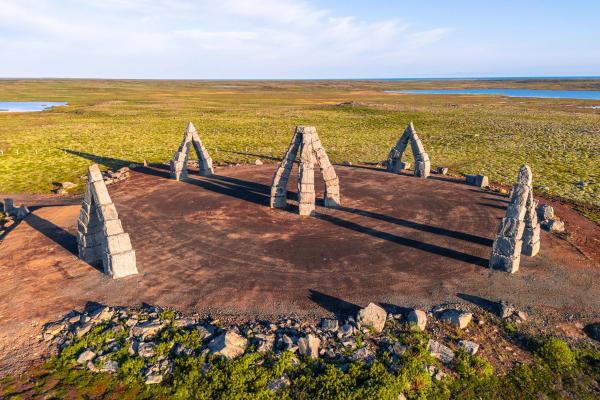
Norse Mythology Ties of the Arctic Henge
The Arctic Henge has been built drawing inspiration from Völuspá, often translated as "The Prophecy of the Seeress." This medieval poem from the Poetic Edda is one of the most significant sources of Norse mythology, offering a sweeping narrative of the universe's history. Narrated by a völva, a prophetic seeress, to the god Odin, it tells the story of the creation of the world, its coming end, and its subsequent rebirth.
Völuspá explores profound themes: fate, the cyclical nature of existence, and the interplay between order and chaos. These resonate in the Arctic Henge's design, where the structure's circular form and light-capturing elements symbolize eternal cycles—like the poem's vision of destruction leading to rebirth. The monument's creator, Erlingur Thoroddsen, and artist Haukur Halldórsson drew from Völuspá not only as a tribute to Norse mythology but also to create a place that is in constant change.
The Central Role of Dwarfs
Dwarves (dvergar in Old Norse) play a pivotal role in Norse mythology, and the Arctic Henge dedicates a significant portion of its structure to them. In Völuspá, 72 dwarves are listed. In the henge, 72 smaller stones encircle the central column, each named after a dwarf from the poem. Each dwarf represents 5 days of the year (72 dwarfs × 5 days = 360 days, approximating a solar year). For this reason, they have been placed in a circle around the central piece to symbolize the cycle of the years. This detail allows visitors to find "their" dwarf based on birthdate.
All of these dwarves have their name, and some of them have become quite famous. The reason is that J. R. R. Tolkien, a writer familiar with the Völuspá, used some of these names for the dwarves in his book The Hobbit. Even the wizard Gandalf is from the poem.
Additional Mythological Elements and Structures
Beyond the dwarves, the henge incorporates more Norse symbols. The Bifröst Path, leading from the parking to the monument itself, references the rainbow bridge linking Midgard (human realm) to Asgard (gods' home), symbolizing a transition from everyday life to the sacred.
There are plans underway to add more elements and finish the Arctic Henge:
- Altar of Fire and Water (northeast): Represents elemental forces central to Norse rituals, with a flame and water bowl for meditation or offerings.
- Polaris Pointer (northwest): It aligns the center of the henge with the North Star, vital for navigation and symbolizing guidance.
- Solar Throne (southwest): Marks the position when the midnight sun is located during the summer solstice.
- Beam Choir (southeast): A pillar passage for energy flow, evoking transformation and mythic rebirth.
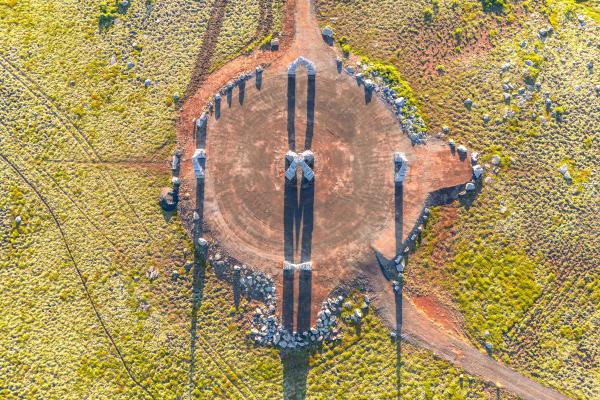
Raufarhöfn
The Arctic Henge is located just outside Raufarhöfn, Iceland's northernmost mainland village. There’s a small village on an island off the north coast, Sandvík, that is a bit further north. But on the main island, Raufarhöfn holds the title. This town is the perfect example of the quiet charm of remote Icelandic life. It used to have a thriving herring industry that declined after the 1960s.
With a population under 200, this fishing community on the Melrakkaslétta peninsula feels like the edge of the world. It's a place where daily routines revolve around the sea, and visitors can experience authentic local culture away from tourist crowds. It’s not the typical place with a buzzing activity, but it’s nice to take a walk around the harbor to watch boats come in with the day's catch or hike along coastal paths to watch birds. Puffins and arctic terns come here to nest in summer.
For dining, there are a couple of options. The local café, Kaupfélagið, offers simple Icelandic fare like fresh fish soups, lamb dishes, and skyr-based desserts. The other one is the restaurant at Hotel Norðurljós, with sea views. If you prefer to cook your own meals in your campervan, the village has a basic grocery store for supplies like bread, cheese, and local produce.
Apart from eating, the surrounding area is quite nice, with several natural features. A short drive or walk leads to beaches with black sand. There’s a small peninsula in the town where Raufarhafnarviti, an orange lighthouse, stands. The views from there are really nice.
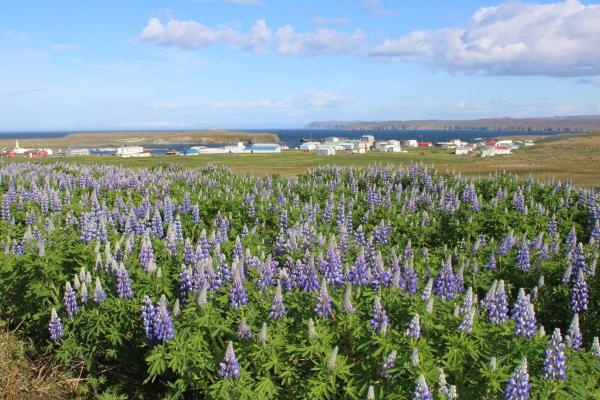
Where's the Arctic Henge and How to Get There
As we have already mentioned, the Arctic Henge has been built on a hill overlooking Raufarhöfn, in northeast Iceland. The best way to get there is by having your own vehicle. This place is remote, and the options for public transport are very limited. Even then, once you get there, you’ll want to have the freedom to explore the area and natural monuments nearby. For these reasons, there’s no better way to travel up there than renting a campervan. Roads are generally paved, but the conditions can change drastically due to the weather, so check them on the Icelandic Road and Coastal Administration website, especially outside the summer months.
From Reykjavík
The trip to the Arctic Henge from Iceland’s capital is a long one, but the itinerary is part of the adventure. You can consider making it in three or four days, stopping at other natural monuments, and creating your own route.
It’s a scenic 600-kilometer (373-mile) road trip that takes about 8 hours to complete. First, take the famous Ring Road (Route 1), the main road in the country, heading north. Continue on it for about 400 kilometers (250 miles), and once you’ve passed Akureyri, the most important city in North Iceland, take a left turn onto Route 85. Drive on it for some time until you see the sign for Raufarhöfn or Route 874. Keep going until you hit Raufarhöfn. The henge is just outside the village, so you can’t miss it.
From Akureyri
Akureyri is the second largest city in Iceland and is often called the “capital of North Iceland.” From there, the drive is shorter, approximately 200 kilometers (124 miles) and takes about 2.5 hours. Head east on Route 1, then left onto Route 85, following it to Raufarhöfn as described before.
What to See and Do Near the Arctic Henge
Traveling so far up north requires time and effort. But don’t worry, you can have a phenomenal Icelandic adventure there. Luckily, the Arctic Henge is not far from some of the most amazing and jaw-dropping attractions in the country. In fact, it’s close to the Diamond Circle, a great scenic route that connects some of the best things to see in this part of the country. It’s a 250-kilometer (155-mile) loop with geothermal wonders, waterfalls, and canyons. Additionally, it is also the best place in Iceland to see whales.
Ásbyrgi Canyon
If you are interested in Norse mythology, like the Arctic Henge, this place is another great example of the connection between nature and legend that so often happens in Iceland. Ásbyrgi Canyon is a horseshoe-shaped gorge that looks so good that it can seem artificial. The canyon walls rise 100 meters (328 feet), and there’s a birch forest at the bottom, something rare in this country.
There are several trails that allow you to explore every corner, from the charming pond in the middle of the forest to going all the way up for panoramic views.
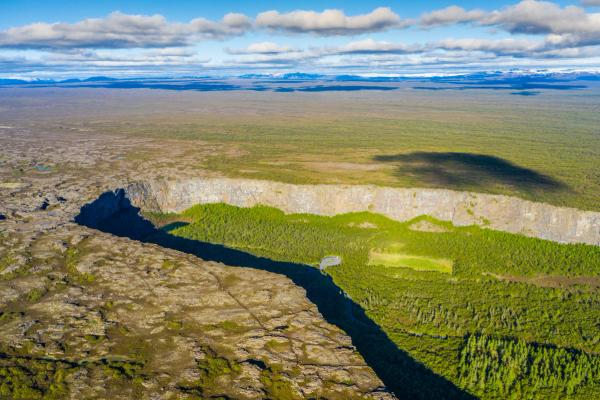
Dettifoss
The next stop is the second most powerful waterfall in Europe: Dettifoss. It has a drop of 44 meters (144 feet) and is 100 meters (328 feet) wide, creating a roar that can be heard from quite some distance. Its raw power is something to behold, and one feels really small standing in front of this beast. A short hike from the parking lot leads to different viewpoints, one on each side of the river. There are two smaller waterfalls nearby, Selfoss and Hafragilsfoss, both within walking distance, making the experience even better.
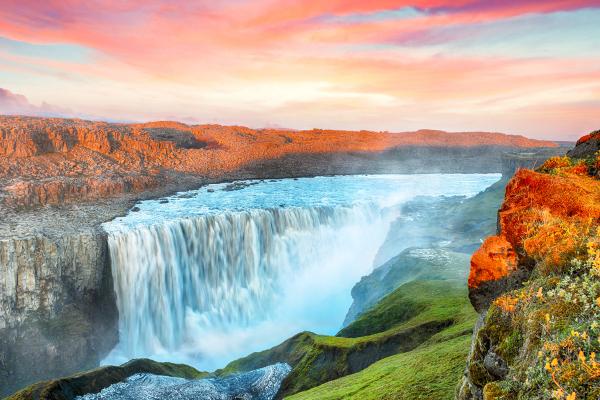
Húsavík
If you want to see whales during your trip to Iceland, Húsavík is the place to go. Iceland is one of the prime destinations in the world for this activity and this town in the north coast is known as the “whale-watching capital of Iceland.” Several companies offer tours into Skjálfandi Bay to see these huge mammals from up close. The best time is summer, when the probabilities of spotting orcas, Minke whales, dolphins, and, if you’re lucky enough, blue whales, are quite high. You can also learn more about these giants of the sea in the Whale Museum. The town's colorful wooden houses and church add charm, with cafés where you can try local food.

Goðafoss
Goðafoss, or "Waterfall of the Gods," is also part of the Diamond Circle. It's not as big or powerful as Dettifoss, but its charm resides in its astonishing looks. It’s a 12-meter cascade with a crescent or horseshoe shape, and the water is of an intense turquoise color. It gets its name from a historic event that happened here. In the year 1000 AD, local chieftain and law speaker Þorgeir Ljósvetningagoði threw his pagan idols into the waterfall to symbolize the nation’s conversion to Christianity.
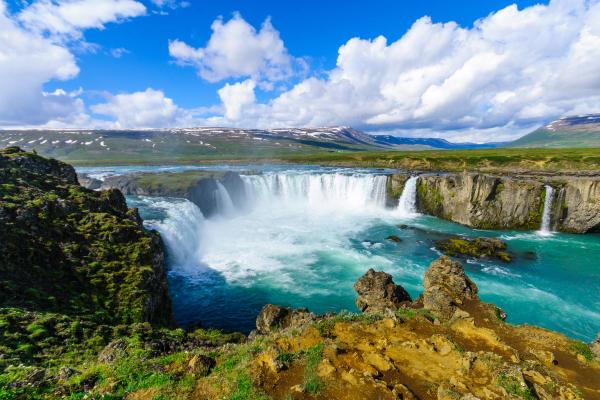
Lake Mývatn
Formed by an eruption over 2,000 years ago, Lake Mývatn is a volcanic wonderland. This lake, with its intensely blue water, is surrounded by lava fields and bubbling mud pots. You’ll also find pseudo craters, formed when lava met water and cooled down rapidly. The lake is surrounded by wetlands that are full of different bird species.
Close to the lake’s shore, you'll find the Mývatn Nature Baths, a geothermal spa. If you go to Lake Mývatn, don’t miss Dimmuborgir, a labyrinth of unique lava formations.

Where to Stay Near the Arctic Henge
One of the best ways to discover the Arctic Henge and its surroundings is to take a road trip through this region of Iceland. There are many campsites near the Arctic Henge, so you can continue your adventure afterwards.
Raufarhöfn Camping Ground
Distance to Arctic Henge: 1 km (0.6 miles). Opening period: June 1 to September 15.
This campsite is located in a peaceful spot by a pond, within walking distance of the henge and all the services available in the village, such as a gas station, shops, and restaurants. Facilities include toilets, showers, electricity, a washing machine, and access to the nearby sports center, which has a swimming pool and a hot tub.
Kópasker Camping Ground
Distance to Arctic Henge: 43 km (27 miles). Opening period: June 1 to September 1.
Located in the village of Kópasker, this site has pitches for tents and campervans in a low area sheltered from the wind. It’s basic but well-equipped with sinks, showers, toilets, electricity hookups, and hot water. There's a BBQ area, and it's close to shops, restaurants, and a pharmacy.
Þórshöfn Camping Ground
Distance to Arctic Henge: 69 km (43 miles). Opening period: June 1 to September 15.
This camping ground is situated in a peaceful and beautiful location, in the town of the same name. The campsite has toilets, showers, electricity, and tables and benches. In the village of Þórshöfn, you can find a health care point, a pharmacy, a restaurant, a grocery store, a gas station, a post office, and a bank.
Ásbyrgi Camping Ground
Distance to Arctic Henge: 72 km (45 miles). Opening period: May to September.
This campsite is located by the birch woods near Ásbyrgi, the astonishing canyon that is part of the Diamond Circle. The natural environment is outstanding, with trees that shelter the pitches from the wind. It has toilets, showers, electricity, cooking facilities, and a laundry room. It’s quite big, with a capacity of 500 people, but it’s recommended to book in advance, as it’s quite popular. Some of the trails that go to the canyon start right at the campground.
Lundur Campsite
Distance to Arctic Henge: 64 km (40 miles). Opening period: June 10 to August 31.
Also in the Ásbyrgi area and not far from the coast, Lundur has flat grassy pitches with electricity, toilets, showers, and an outdoor sink. It’s a basic camping ground, but it’s close to services and activities, such as a playground for children, a shop, and a restaurant.
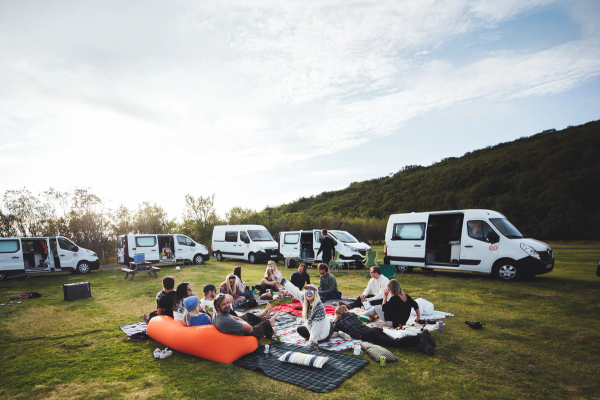
The Weather at the Arctic Henge
Summer (June to August) brings mild temperatures of 10-15°C (50-59°F) and near-constant daylight, ideal for exploring the different light effects created by the Arctic Henge. It’s also the best time for road travel, as all of the roads are usually open. There are always chances of rain and wind, especially being so close to the sea.
Autumn (September to October) sees temperatures drop to 5-10°C (41-50°F), with higher chances of rain. However, the fields and vegetation turn into beautiful fall colors. The days shorten every week, and there could be the first days of snow by mid-October. On the other hand, there are few tourists.
Winter (November to March) is a difficult time to travel through Iceland, but it also has its advantages. The Arctic Henge is covered in snow, creating a beautiful postcard. The days are really short and the sun barely rises by the end of December, so it’s crucial to plan your visit for the moments with natural light. The sun rays are quite horizontal, so the effects created in the henge are different to the rest of the seasons. On clear nights, there are good chances to see the Northern Lights. If that happens, you’re a lucky person, as the Arctic Henge looks especially mystical under the aurora.
Spring (April to May) warms to 0-5°C (32-41°F), with melting snow revealing green fields around the henge. The weather mixes sun and showers, and the days grow longer week after week. There can still be lingering snow and ice on the roads, so drive safely.
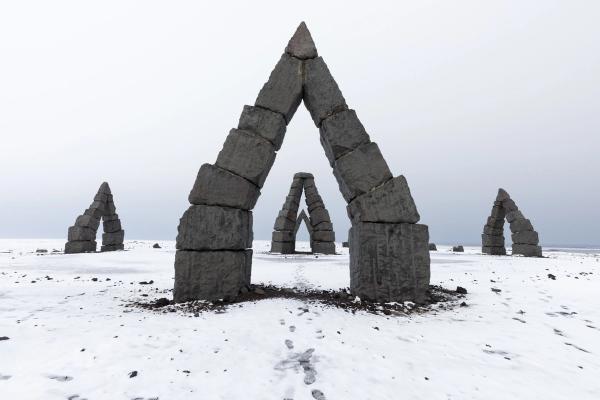
What to Pack to Visit the Arctic Henge
- Waterproof jacket and pants to handle sudden rain or wind.
- Layered clothing, including thermal base layers, fleece, and a waterproof jacket. In winter, a good, warm coat.
- Sturdy hiking boots.
- Gloves, hat, and scarf, especially outside summer.
- Sunglasses and sunscreen for sunny days.
Travel Tips
- Visit in summer for the extended daylight, so you can see the Arctic Henge at different hours to see how the light interacts with the monument. Or in winter, when there are chances to see the Northern Lights.
- Rent a 4x4 campervan for winter to handle the potential tricky driving conditions.
- Respect the environment around the henge. Don’t wander off marked paths and pack out all your trash.
- Time your visit for sunrise or sunset to capture the henge’s best light for photography.
- Most campsites in the region close during the colder months. Look for alternatives if that’s the case.
- Download an aurora forecast app if visiting in winter to track northern lights activity.
- Embrace the remote solitude; it’s a key part of the Arctic Henge’s unique charm.
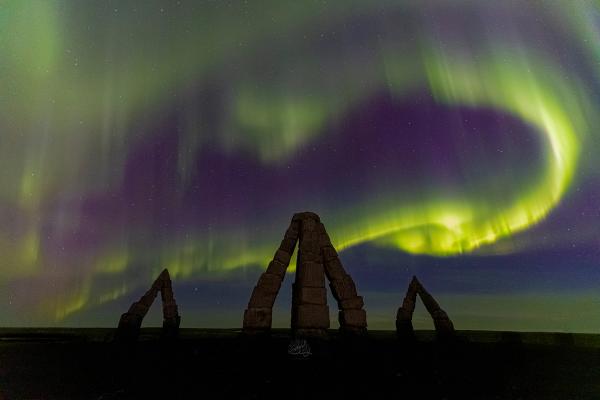
Conclusion
Venturing to the Arctic Henge is an experience that brings together an outstanding natural environment, a monument created by local artists, and a deep connection to Norse mythology. It’s also a place where you’ll have a sense of freedom and isolation that is difficult to find anywhere else. This place is at the edge of the world. Pack your gear, hit the road, and discover why this remote gem deserves a spot on your itinerary.

